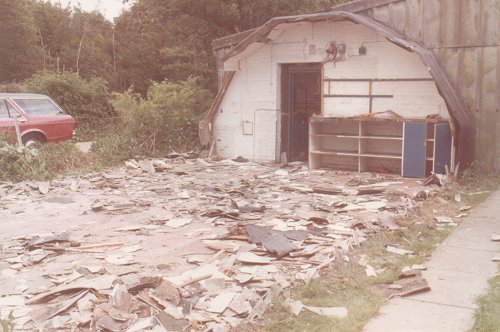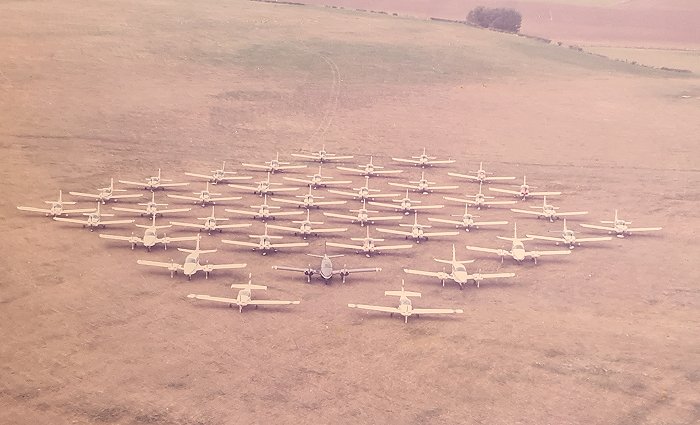1982 - A year of small changes.
In 1980, the Gulfstream School of Flying had moved into the north offices, a small block at the end of Hangar J. The offices and classrooms were used for students and instructors to conduct briefings before going flying. In its first two years, the school expanded in terms of both the number of aircraft it operated and the number of instructors it employed. It quickly became clear that the school needed more room to conduct its business efficiently. Behind the office block was a Second World War Nissen hut that was used as an engineering and tool store, so it was decided to demolish this in order to extend the office block. Planning permission was received and the work was completed in July.
|

The old Nissen hut demolition nearing completion, the characteristic arched shape is clearly visible in the remaining end wall.
|
|

The new office extension is built on the site of the Nissen hut. The work is seen nearing completion in July.
|
The name Gulfstream School of Flying was chosen to reflect the types of aircraft the company, Hana Aviation, operated in its fleet at their Denham, Elstree and Biggin Hill bases. Gulfstream American Aviation Ltd produced the Cheetah a four-seat aircraft principally for training and the Tiger with a larger engine to make it more attractive for touring. The Cougar was a twin-engined aircraft that the school mainly used for pilots to train for twin and instrument ratings. With these qualifications, pilots would often go on to become Airline Pilots.
In July, to celebrate the opening of their new offices, the entire fleet of 39 aircraft were gathered for a special photograph on the grass at Denham. This consisted of 31 Cheetahs and Tigers, five Gulfstream Cougars and interestingly two Slingsby T67 Firefly aerobatic trainers. On average eleven of these aircraft were permanently based at Denham at any one time.
|

Hana Aviation, also known as Cabair, assembled their entire training fleet at Denham in July for this remarkable photograph.
|
There were many other small changes at the aerodrome during the year. The radio frequency, which had been 123.500 MHz for many years, was changed to the current 130.725 MHz to avoid interference with other stations as the national civil aviation radio network was steadily expanding.
Tom Howard was still operating the Denham Flying Training School mainly with Cessna 152 and 172 aircraft. Many of the flying instructors were young people gaining experience before applying for work in the airlines. Membership of the club continued to grow and attracted a group of Lloyds Underwriters who were based in London as Denham was their most convenient local aerodrome.
This year the Air Training Corps made an application to the aerodrome for a room in order to act as a base for the local unit, 2370 (Denham) Squadron. The Squadron was having to give up its existing accommodation at the local school, at the end of the year. This was a request that Bickerton's Aerodromes were all too happy to grant as the aerodrome had always supported air minded youth. All of these events were to presage the much larger changes that were to happen the following year, as will be related next.
|

